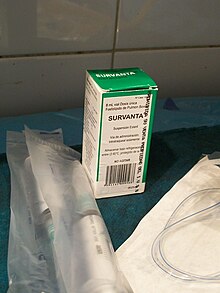Pulmonary surfactant (medication)

Beractant, surrounded by devices for its application.
|
|
| Clinical data | |
|---|---|
| Pronunciation | Curosurf, Survanta, others |
| AHFS/Drugs.com | Monograph |
| ATC code | |
| Identifiers | |
| Synonyms | Beractant, Poractant alfa, others |
| ChemSpider |
|
Pulmonary surfactant is used as a medication to treat and prevent respiratory distress syndrome in newborn babies. Prevention is generally done in babies born less than 32 weeks gestational age. It is given by the endotracheal tube. Onset of effects is rapid. A number of doses may be needed.
Side effects may include slow heart rate and low oxygen levels. Its us is also linked with intracranial bleeding. Pulmonary surfactant may be isolated from the lungs of cows or pigs or made artificially.
Pulmonary surfactant was discovered in the 1950s and a manufactured version was approved for medical use in the United States in 1990. It is on the World Health Organization's List of Essential Medicines, the most effective and safe medicines needed in a health system. In the United Kingdom it costs the NHS 281.64 to 547.40 pounds per dose.
Pulmonary surfactant is used to treat and prevent respiratory distress syndrome in newborn babies. Prevention is generally done in babies born less than 32 weeks gestational age. Tentative evidence supports use in drowning.
There are a number of types of pulmonary surfactants avaliable.
Synthetic pulmonary surfactants
Animal derived surfactants
Researcher John Clements identified surfactants and their role in the 1950s. Mary Ellen Avery soon after show that the lungs of premature infants couldn't produce surfactants.
Exosurf, Curosurf, Infasurf, and Survanta were the initial surfactants FDA approved for use in the U.S.
In 2012 the US FDA approved an additional synthetic surfactant, lucinactant (Surfaxin).
...
Wikipedia
